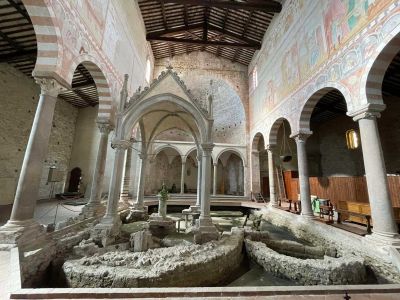Just four miles west of Pisa, an 11th century Romanesque Basilica stands solitary and solemn in an open field. The medieval basilica San Piero a Grado (also known as the Basilica di San Pietro Apostolo) is fascinatingly unique for many reasons.
The Basilica lacks a façade but features two apses. In one apse stands the first stone altar ever erected in Italy. It was likely the first place of Christian worship in the Pisa area. Adorning the Basilica’s nave is the only intact medieval fresco cycle in Italy portraying the earliest popes from St. Peter to Pope Giovanni VII (proclaimed Pope in 1003).
The 14th-century frescoes by Deodato Orlandi are characteristic of a Romanesque nave. The frescoes just above the arches depict portraits of all the popes from the first, St. Peter, to Pope John VII (1033). Scenes of classical Rome are frescoed as well, along with a row of windows surmounted with recessed arches, depicted skillfully in three-dimensional perspective with angels peeking out of each window.
The church also houses one of the oldest wooden confessionals in existence crafted in 1628 by a Pisa legnaio (“one who works in wood”), Giuseppe San Martini. According to legend, in 42-44 A.D., St. Peter himself once preached on this site enroute from Palestine. During a violent storm at sea, he found safety on this strip of land near Pisa called “Gradus Arnensis”.
In Roman times, this was the last ferry stop on the Arno River. The Basilica’s name, San Piero a Grado, indicated a terraced level (gradone) along the Arno, generated by frequent flooding of the river. The continuous overflow of the Arno ramified here thus forming the huge fluvial and maritime basin of Pisa.
The massive stone under the late Gothic (13th – 14th century) ciborio (a ciborium is a structure built to highlight the altar) is said to be the site where St. Peter preached. Under the ciborium, a crucifix and plant sit on an ancient column called “la colonna di San Pietro”, which is placed on the flat rock where the Saint evangelized, according to tradition. The western apse of the church rises behind the “St. Peter column” on the site of his sermon. When standing in front of that western apse, one views the central apse at the eastern end of the church.
The absence of a façade is likely due to a lightning bolt or flooding of the Arno which destroyed the front of the original structure. In its place, a large apse was built, and an access door was created on the north side of the church. Massive blocks of classical spoglio flank the door.
A great campanile (bell tower) was built during this time as well, but in July 1944, it was destroyed by the retreating Germans for fear it could be a lookout point of surveillance. The rubble remains as do early photographs depicting the Basilica and its tall-standing bell tower.
Near the western apse stands St. Peter, sculpted in white Carrara marble in the 18th century. The bearded San Pietro carries the cross of his martyrdom with an upraised hand and gaze. Just to his left, stands the wooden confessional.
Many a treasure fascinates the visitors of San Piero a Grado.
https://www.lagazzettaitaliana.com/travel/10241-basilica-san-piero-a-grado#sigProId8b0a398c7d




